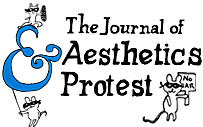
 |
 |
by John Jordan
We have to stop pretending that the popularity of politically engaged art within the museums, magazines and markets over the last few years has anything to do with really changing the world. We have to stop pretending that taking risks in the space of art, pushing boundaries of form, and disobeying the conventions of culture, making art about politics makes any difference. We have to stop pretending that art is a free space, autonomous from webs of capital and power.
It’s time for the artist to become invisible. To dissolve back into life.
Its not a plea to take art to the streets or bring life into thegallery, theatre and museum - both those things have taken place continuously over the last century. It's a plea for the artists to abandon our identities but not our creativity,
It's a plea to value our creativity more, to understand its’transformative power and apply it directly to social change, to social movements, to acts of disobedience and strategies of survival.
It's not a plea to lay down arms, to give up the weapons of imagination, far from it. We should never abandon beauty; never forget the joy of creativity, the strength of our visions.
What Marcuse calls arts ability to challenge the monopoly of accepted reality is perhaps our most powerful weapon and one that all rebellions desperately need if they are to create e new ways of living. Its time to recognize that art should never have existed as a category separate from life.
Its time to rewrite Flaubert and to perhaps say,"Life is so horrible
that we can only bear it if we know we are changing it. And that can be only
done by leaving the world of art."
__________________________________________________________
There's a big difference between taking risks in the world of art and in the world outside. In the art world when you provoke, disobey the rules, push the boundaries, and question the cannons you get discovered, rewarded, acclaimed. In the real world you are marginalized, surveilled, beaten and imprisoned.
There have been many times I have wanted to return to the safety and comfort of the art bunker - when plain clothes police officers spent a week following me as I took my son to school, when Special Branch raided my flat. When I was framed for something I never did. When the group I worked in couldn't recover from the vicious campaign of criminalization by the British media and the state.
But I stayed outside. I knew where I was most effective and I paid the price for deserting the art system, the price for applying radical creativity to places which are out of bounds, real places, places where it made a real social difference.
I couldn't pretend anymore.
Listening to the screams of people as they were beaten to a pulp while they slept in their sleeping bags in the Diaz School during the night of revenge by the Italian state in Genoa after the massive G8 protests. Witnessing broken teeth, ribs and jaws, punctured lungs and 66 people carried out of the raid on stretchers. Seeing the long streaks of blood smeared across a white marble floor, smelling fear and terror in the empty school building.
It felt real to me. More powerful than any drop of blood, pain or violence I've seen in live art.
Hearing about a middle aged woman breaking into an RAF base last week and causing 25 million pounds of damage to a Tornado Bomber with a hammer and calmly waiting for the police to arrest her, risking many years in prison.
It felt real to me. More courageous and more useful than any durational performance
Witnessing a large medieval catapult firing teddy bears and soft toys over the fence erected around the summit of the Free Trade Area of the Americas in Quebec. Pulling the fence down and dancing on its back while it bent and buckled. Seeing the clouds of tear gas rise above the city, fired at the rate of one a minute for 3 days and nights. Laughing as someone expertly hit the gas canisters back towards the police with an ice hockey stick.
It felt real to me. More absurd, more adventurous and often more dramatic than any theatre.
Observing an entire society creatively dealing with complete economic collapse in Argentina. Hearing about the government being deposed by the sound of millions of clashing pots and pans. Watching bankrupt factories being occupied and run by the employees themselves. Witnessing those who have nothing experiment with ways to grow food and work autonomously from capitalist systems. Listening to neighborhood assemblies debate the future of their communities, practicing direct democracy without leaders or representatives, while standing in a circle on a Buenos Aires street corner.
It felt real to me. More sustainable, more participatory and on a much larger scale than any socially engaged site specific art practice.
I could speak for hours of the extraordinary creativity I've seen displayed by the anti-capitalist movements across the world. I just want to say,“There's an unprecedented global social movement out there.”
A movement of movements which is the living embodiment of the slogan"one no and many yeses."
The"no"is a clear rejection of the single economic blueprint where the rule of capital is absolute, while the"many yeses"refer to the multitude of diverse, people-centered alternatives.
The act of desertion is not just saying no. In fact its saying yes-
Yes to other ways of running our society.
Yes to a future without war.
Yes to a culture of life.